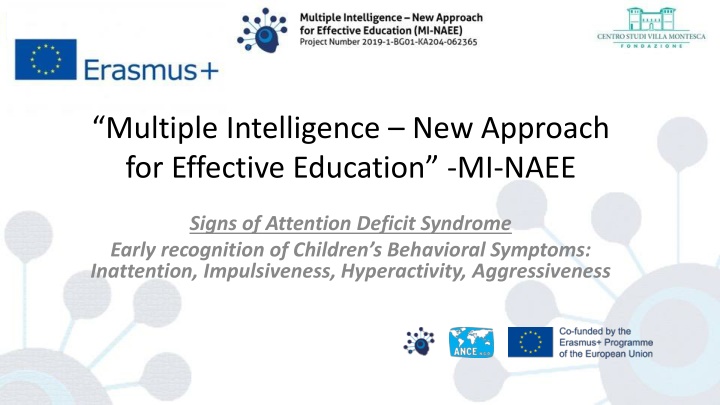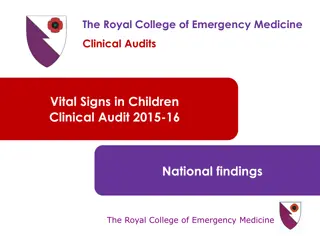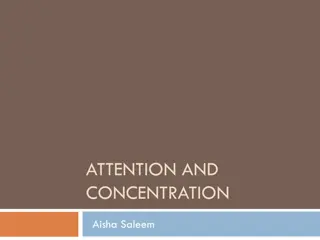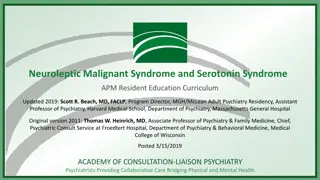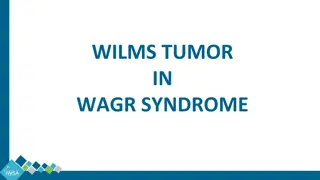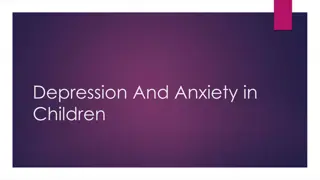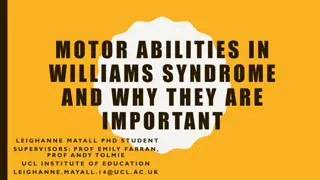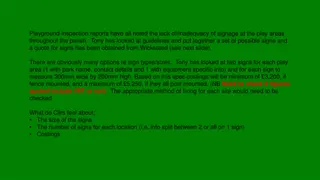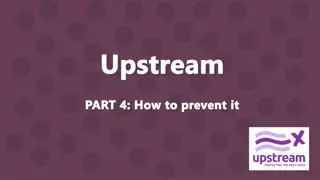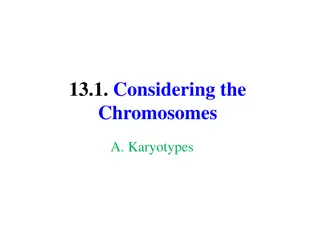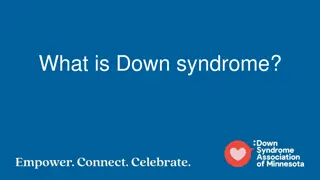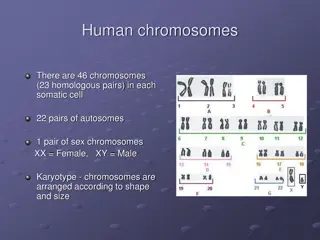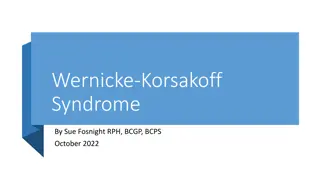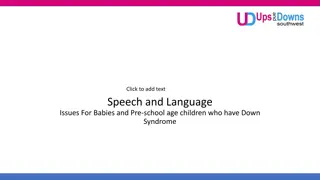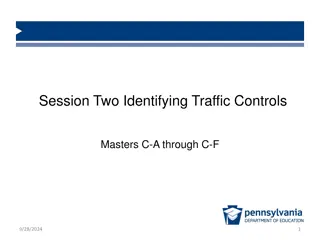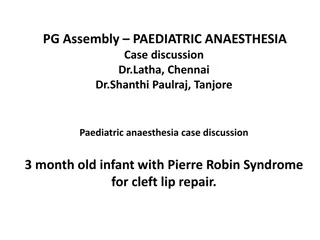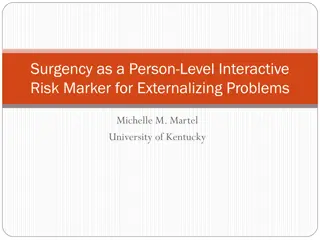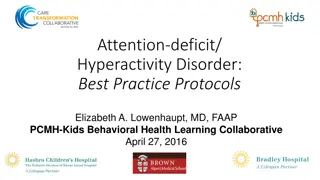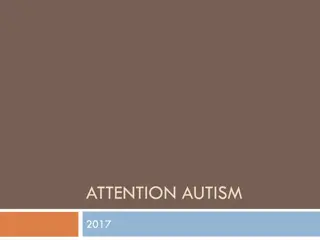Recognizing Signs of Attention Deficit Syndrome in Children
Early recognition of behavioral symptoms such as inattention, impulsiveness, hyperactivity, and aggressiveness is crucial in identifying Attention Deficit Syndrome. This content explores the theoretical approach, primary diagnostic symptoms, cognitive and behavioral symptoms, and practical educational solutions for children with ADHD.
Download Presentation

Please find below an Image/Link to download the presentation.
The content on the website is provided AS IS for your information and personal use only. It may not be sold, licensed, or shared on other websites without obtaining consent from the author.If you encounter any issues during the download, it is possible that the publisher has removed the file from their server.
You are allowed to download the files provided on this website for personal or commercial use, subject to the condition that they are used lawfully. All files are the property of their respective owners.
The content on the website is provided AS IS for your information and personal use only. It may not be sold, licensed, or shared on other websites without obtaining consent from the author.
E N D
Presentation Transcript
Multiple Intelligence New Approach for Effective Education -MI-NAEE Signs of Attention Deficit Syndrome Early recognition of Children s Behavioral Symptoms: Inattention, Impulsiveness, Hyperactivity, Aggressiveness
Contents Theoretical Approach Teacher s role Primary diagnostic symptoms Cognitive symptoms Problem Solution/practical educational methods Behavioural symptoms Problem Solution/practical educational methods Options for students with ADHD https://www.singlecare.com/blog/child-misdiagnosed-adhd/
Theoretical Approach Definition (simplified) Attention Deficit Syndrome: A neurodevelopmental disorder due to dysfunction in the central nervous system. According to Diagnostic and Statistical Manual of Mental Disorders1, neurodevelopmental disorders could possibly be considered as hereditary, yet it may affect a person throughout her/his entire life. Greek Law N.3699/2008, recognized children with Attention Deficit and Hyperactivity Disorder (ADHD) as individuals in need for special educative needs. The Salamanca Statement: inclusive education - all children have the right to be educated. Regular schools with inclusive orientation are the most effective means of combating discriminatory attitudes, creating welcoming communities, building an inclusive society and achieving education for all; moreover, they provide an effective education to the majority of children and improve the efficiency and ultimately the cost-e ffectiveness of the entire education system. Scandinavian countries, UK, Germany, Italy, France present a long tradition, higher level of research and advanced methods on special education, due to increased sensitivity considering social perception and citizens well-being. 1Diagnostic and Statistical Manual of Mental Disorders, Fifth Edition, DSM - 5, p.31 2The UNESCO Salamanca Statement, Salamanca, Spain, 1994
Theoretical Approach Indicative possible factors Genetic and physiological: First-degree biological relatives (heritability/genes) Visual/hearing impairments Metabolic abnormalities Sleep disorders Nutritional deficiencies Epilepsy Physical anomalies Temperamental: hyper expressing individuals effortful control negative emotions enhanced novelty seeking Environmental: Smoking and diet during pregnancy Abuse or neglection Multiple foster placements Neurotoxin exposure (e.g., lead) or Alcohol exposure in utero Infections (e.g., encephalitis)
Teachers role The teacher must set the suitable/proper framework and the conditions for the cognitive, behavioral, sensory and psychological development of students. The teacher must form the appropriate interpersonal relationships with the students and adapt the daily educational program to the needs required by each case individually, as required by the inclusive / total philosophy of the contemporary regular school. The teacher must observe how, when, and why the child is abstract, impulsive, hyperactive, nervous / aggressive, and formulate the appropriate educational practice. https://readtothem.org/why/kindergarten-teacher-helping-students-with- reading-skills/
Primary diagnostic symptoms ADHD A disorder affecting: a) The ability of the student to control and self- regulate his/her behavior b) The ability of the student to concentrate and maintain attention c) The student s school performance (negatively) https://medium.com/invisible-illness/brain-scans-show-that- certain-areas-of-the-brain-are-less-well-supplied-with-blood- and-therefore-b53a4e4e591b
Primary diagnostic symptoms Cognitive symptoms Problem & Practical educational methods There are two areas of symptoms: a) Inattention b) Hyperactivity / impulsivity Whereas, The intensity and degree of severity may vary in each student case. Some of the above categories (a, b) may be more intense than the other one, or they may both coexist in the same degree (intense or low). These symptoms should be considered based on the age and the developmental level of the student. https://www.shutterstock.com/search/adhd Early diagnosis ensures the right direction in terms of appropriate training techniques.
Primary diagnostic symptoms Cognitive symptoms Problem & Practical educational methods Inattention The student often: Fails to give close attention to details or makes careless mistakes in schoolwork, at work, or with other activities Has trouble holding attention on tasks or play activities Does not seem to listen when spoken to directly Does not follow through on instructions and fails to finish schoolwork, chores, or duties in the workplace (e.g., loses focus, side-tracked) Has trouble organizing tasks and activities Avoids, dislikes, or is reluctant to do tasks that require mental effort over a long period of time (such as schoolwork or homework) Loses things necessary for tasks and activities (e.g. school materials, pencils, books, tools, wallets, keys, paperwork, eyeglasses, mobile telephones) Easily distracted Forgetful in daily activities https://brainandbodyintegration.com/neurodevelopmental- evaluations/attention-deficit-hyperactivity-disorder/
Primary diagnostic symptoms Cognitive symptoms Problem & Practical educational methods Inattention The teacher: Practical Educational Method Objective Clear & simple instructions, keywords, newspapers, magazines Minimized confusion of the student Presentationof assignments in the form of blueprint and notes Organization of the mind targeted recording of information avoidance of non-completion and disorientation Expansion tires under the chair Keep the student calm and concentrate on the lesson reducing pointless wandering in the classroom Placing a clock on the student s desk Multi-sensoryperception gradual development of psycho- emotional balance through achieving the goal Group work in and out of classroom Cultivation of collaboration sense personal satisfaction after completing the group work development of good behavior Knowledge Map Including two cognitive layers 1st: who, when, where 2nd: what, how, why Organization of the mind identifying key information of a given text cognitive development
Primary diagnostic symptoms Cognitive symptoms Problem & Practical educational methods Inattention Practical Educational Method Objective Co-teaching classes within the same classroom 45 lesson divided into: 20 teaching (all) A) 20 silent work to enrich knowledge (regular students) B) 20 consolidation work (ADHD students) 5 revision of day s lesson Uninterruptedlesson - smooth outcome of the lesson with the participation of all students improved understanding recall of previously gained knowledge students level identification via tests Teaching learning and study strategies using cognitive learning ( do what I do, let s do it together, do it yourself ) Meta-cognitive evaluation ( what I knew, what I learned, how I learned it, what mistakes I made, how I corrected them, how well I learned, what I didn t learn well, how what I learned will it help me ) Students develop strategies on studying and learning step by step in regular school. Use of projector for students 8-11 years old, colored teaching materials, blueprints, images. Gradual introduction to technology, creative and fun way of learning, maintain the students attention in an entertaining and visual way Use of mobile phones for students 15-17 years old interactive learning games/puzzles Gaining the interest of high-tech students no discrimination for those answered wrong, as only the teacher knows who answered what -
Primary diagnostic symptoms Behavioral Symptoms Problem & Practical educational methods Hyperactivity/Impulsivity The student often: Fidgets with or taps hands or feet, or squirms in seat Leaves seat in situations when remaining seated is expected Runs about or climbs in situations where it is not appropriate (adolescents or adults may be limited to feeling restless) Unable to play or take part in leisure activities quietly On the go acting as if driven by a motor Talks excessively Blurts out an answer before a question has been completed Has trouble waiting their turn Interrupts or intrudes on others (e.g., butts into conversations or games) http://aprilseventheblog.blogspot.com/2015/06/attention- deficit-hyperactivity-disorder.html https://engagingdisability.org/attention-deficit-hyperactivity- disorder/
Primary diagnostic symptoms Behavioral Symptoms Problem & Practical educational methods Hyperactivity/Impulsivity The teacher: Practical Educational Method Objective Placing the student in the front desk for direct communication and guidance Constant visual contact and communication with the student, direct supervision Student writes on the whiteboard the highlights of the lesson, showing a country on a map, distributing teaching materials to the classmates Student s energy relief, keeping the mind of the student busy while engaging socially with the other students The Rules of Democracy in the class for students (6-15 y.o.) (e.g. raise hand before you speak, wait for the speaker to finish, every idea is respected, etc.) Sign language (age range of 3-5 y.o.) (Red handkerchief = silence VS. Green handkerchief = give the floor to the next) Improve self-control of impulsive movements and reactions Informal/Alternative learning environments (e.g. museum, park, etc.) Cognitive, emotional, social development, and enhancement of multi-sensory perception. Student-Teacher Contract sets the mutually agreed behavior of the student, while any violation comes with consequences Parental monitoring of daily behavior of the student, hence either reward or punishment may follow. Interdisciplinarypsychokinetic games Highlighting playful learning development of expressive and communicative vocabulary while enhancing the cognitive, kinetic, social, and behavioral skills
Options for students with ADHD Example case for a student with ADHD in regular school: - The teacher identifies/acknowledges cognitive or behavioral disorder inthe student - The teacher suggest for the student to be examined by Special Center for Educational, Consulting, and Psychological Support (e.g. in Greece such services are offered by K.E.S.Y.) - Special Center for Educational, Consulting, and Psychological Support identifies the disorder, its severity, and suggest the proper intervention(s), such as: Parallel support offered by special education teacher (option used within the regular class) Inclusion class (option within the regular school for a number of students) Special school (option when the student exhibits - along with ADHD - psychological problems, e.g. autism, mental retardation) - The teacher modifies the educational process according to the report of the Special Center for Educational, Consulting, and Psychological Support (interventions)
Conclusions The evaluation of the student, the accurate assessment of the difficulties and the formation of a thorough and individualized teaching program, are the preconditions for the elimination and improvement of the problem. The formation of an environment in which the effort made by the student with ADHD will be praised, will prove beneficial for the student s improvement and further development. The ultimate goal is the enhanced functionality and autonomy of those students, so that they can equally claim their rights in educational, professional, and social context. https://www.barewalls.com/canvas- print/finish-line-green-road- sign_bwc7131298.html?cf=no_filter
Topics for Discussion Challenge A As a hatching teacher, you are asked to undertake through the method of participatory observation , the supervision of the behavior of a student with ADHD at your neighborhood school for a period of one (1) month. In the participatory observation dairy , what would you record from the overall outcome of this activity? https://www.chronicle.com/article/the-holy-grail-of-class- discussion/ ChallengeC Challenge B Watching a video presenting a child with ADHD Many hatching teachers are hesitant and fearful of having an ADHD student in their classroom, due to their increased worriedness of the outcome of their careers. What would be the arguments to persuade the school teacher to willingly accept a student with ADHD in his/her classroom? (video link: https://youtu.be/knOJXVTBCMg) Comments welcomed
Bibliography/References 1. Griva E. & Semoglou K., (2012), Foreign Language and Game Kinetic Activities of creative expression in elementary education, Kyriakidis Publication 2. Salvaras I., (2019), Teaching children with special needs in regular school 3. Stasinos D., . (2020), The Special Inclusive Education 2027. The attractive deployment into the New digital school with digital champions , Athens, Papazisi Publication. 4. Tomaras N., (2019), Learning Difficulties or Symptoms. From equal opportunities in education to an inclusive society , Pataki Publication 5. Wahlstedt, C., Thorell, L.B.,& Bohlin, G. (2009), Heterogeneity in ADHD: Neuropsychological pathways, comorbidity and symptom domains. Journal of Abnormal Child Psychology, 37, 551-564.
